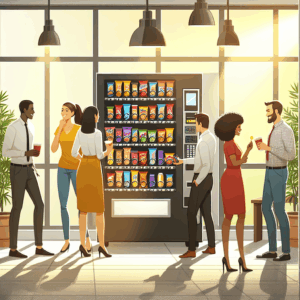The Intricacies of Vending Machine Inventory Management
Understanding Customer Preferences
When it comes to restocking vending machines, knowing what customers want is crucial. You can’t just fill up a machine with random items and hope for the best. It’s a matter of observing trends and preferences continuously. Every location has its unique demands; for instance, a gym vending machine will have different needs compared to one in an office building.
Imagine checking the vending machine sales reports and noticing an increase in healthy snack sales. That’s a clear indicator that you should stock up more of those items. It’s like having a constant conversation with your customers without speaking a word.
Also, sometimes it’s essential to introduce new products to see how they perform. New trends in snacks and drinks can bring some excitement and draw in more customers. It’s all about balance and variety while keeping tabs on what works and what doesn’t.
Tracking Inventory and Reorder Levels
Inventory tracking is like the unsung hero of the vending machine business. It’s essential to maintain a record of sales to determine when and what needs restocking. You’d be surprised by how quickly you can run out of a popular drink or snack.
I remember when I first started, I learned the hard way the importance of reorder levels. You don’t want to keep too much stock, as it ties up capital, but running out of stock can mean missed sales—such a tricky balance to strike!
With technology today, many modern systems can automate these tracking processes, but it’s still vital to keep a keen eye on the reports. Consider it a safety net to prevent any major stocking mishaps.
Optimizing Product Placement
Product placement within the vending machine can impact sales more than you’d think. Strategic placement can lead to increased visibility of items, thus boosting sales. For instance, the top shelf often gets the most attention, so you want to keep your best sellers there.
There’s also the idea of cross-selling, by placing complementary products next to each other, such as chips and a popular dip brand. You’re not just a restocker; you’re a mini sales strategist trying to optimize the layout to its fullest potential.
I’ve found that rotating products occasionally also helps in capturing customer attention. It prevents regular customers from getting bored with the product lineup. Refreshing the layout can reinvigorate the interest people have in your machines.
Logistics and Planning for Restocking
Route Planning and Scheduling
Effective route planning is a cornerstone of efficient vending machine restocking. You have to consider the distance between machines, the type of product needed, and high-traffic times to optimize the restocking route.
When I started out, I used to think that hitting every machine on the list in one day was the most efficient. Soon, I learned to cluster machines by location and product types, saving time and fuel.
Nowadays, technology offers various route optimization tools that help in choosing the best paths and timing. This kind of improvement boosts productivity tremendously.
Coordinating with Suppliers
Maintaining a good relationship with suppliers can make or break your vending business. Reliable suppliers ensure that the products needed are always available and delivered on time.
It’s always a good idea to have backup suppliers, too. One time, a main supplier couldn’t deliver due to some supply chain issues, but thankfully I had a secondary option lined up, avoiding any potential disruptions.
Moreover, keeping an open line of communication helps in negotiating better prices and finding out about new products that might be in high demand.
Time Management for Efficient Restocking
Time management is crucial because time spent restocking is time not spent selling. The faster you can get the job done effectively, the more time you have to focus on growth and customer relations.
I often set specific goals for how quickly each machine should be restocked based on its size and location. This really helps in staying on track throughout the day.
Sometimes things don’t go as planned, and that’s okay. It’s important to remain flexible but sticking to a well-thought-out schedule usually yields the best results.
Common Challenges and How They Are Overcome
Dealing with Machine Malfunctions
No matter how high-tech, vending machines can still malfunction. Understanding basic troubleshooting is essential to keep business running smoothly.
I’ve learned through experience that often it’s something simple—a stuck product or a jammed coin that causes the issue. Having the right tools on hand can save a lot of headaches.
For more complicated issues, having a reliable technician or service provider on speed dial is a must. The quicker you resolve these issues, the less potential revenue you lose.
Addressing Theft and Vandalism
Theft and vandalism can be incredibly frustrating challenges. Secure placements, like well-lit areas or places with surveillance, can deter potential wrongdoers.
I implemented stronger locks and added signage indicating surveillance to lower the chances of vandalism. Still, it’s essential to check machines regularly to catch any signs of tampering early.
On top of that, insurance can be a safety net in recovering losses from damaging incidents, though prevention should always be the primary focus.
Managing Seasonal Demand Changes
Seasons can drastically impact what products sell. Colder months may see more hot beverages being sold, whereas summer boosts sales of cold drinks and ice cream.
Keeping track of these trends over time helps in planning stock for specific seasons. I’ve learned to adapt quickly as customer preferences shift with the weather.
Additionally, promoting seasonal products using marketing signs near the vending area can drive awareness and increase sales of seasonal items.
The Technology Behind Modern Vending Machines
Cashless Payment Systems
With the world moving towards cashless transactions, having machines that accept mobile payments, cards, and even digital wallets can enhance customer convenience.
Once I adopted the latest payment technologies, I noticed a significant increase in sales, as people aren’t always carrying cash these days.
This shift also minimizes the hassle of dealing with cash collection and counting, making the restocking process more efficient and secure.
Real-Time Inventory Monitoring
Real-time inventory monitoring systems are game-changers. These systems give live updates of stock levels, reducing product shortages and overstock problems.
When I first used these systems, I was amazed at how they simplified restocking and planning. It was like having a complete overview of each machine on my phone.
Inventory alerts ensure you don’t miss out on potential sales due to out-of-stock items, making each machine operate at its maximum potential.
Data Analysis for Better Sales
Analyzing vending machine sales data helps in making informed decisions about stock and machine locations. It’s your personal crystal ball into customer habits and preferences.
I make it a habit to review this data regularly, tweaking stock choices and strategies based on insights gathered. It impacts everything from product choices to marketing tactics for the machines.
This data-driven approach can significantly improve overall sales and customer satisfaction, making you a smarter, more efficient operator.
FAQ
What makes inventory management in vending machines unique?
It requires understanding customer preferences specific to each location and continuously adapting stock to meet those needs efficiently.
How can technology help in restocking vending machines?
Modern systems offer cashless payment options and real-time inventory monitoring, streamlining operations and increasing sales potential.
What are the main challenges in vending machine restocking?
Challenges include machine malfunctions, theft, vandalism, and adapting to seasonal demand changes, which require strategic planning and quick solutions.
Why is data analysis important in vending machine operations?
Data analysis helps operators understand sales trends, optimize stock levels, and improve overall customer satisfaction and business efficiency.



